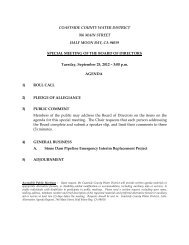Lower Pilarcitos Creek Groundwater Basin Study - Coastside ...
Lower Pilarcitos Creek Groundwater Basin Study - Coastside ...
Lower Pilarcitos Creek Groundwater Basin Study - Coastside ...
Create successful ePaper yourself
Turn your PDF publications into a flip-book with our unique Google optimized e-Paper software.
the annual recharge. This results in perennial yield estimates of 1,813 AFY and 1,507<br />
AFY in 1987 and 1991, respectively.<br />
Perennial (Safe) Yield<br />
The perennial yield of a groundwater basin is defined as the rate at which water<br />
can be withdrawn perennially under specified operating conditions without incurring<br />
adverse impacts (Todd, 1980). The term “perennial yield” is used here instead of safe<br />
yield, which has been widely misinterpreted to be a fixed quantity of water (often<br />
equated to recharge) that could be extracted. Perennial yield embodies the concepts<br />
and intent of City of Half Moon Bay Local Coastal Plan policies (Policy 10-14) which<br />
state that new or increased well production shall be limited to a safe yield factor that will<br />
not impact water-dependent sensitive habitat, riparian habitats, marshes, and<br />
agricultural water use. Perennial yield also accounts for adverse impacts of saltwater<br />
intrusion, land subsidence, and decreased creek flow.<br />
Perennial Yield and Recharge. Perennial yield and safe yield have been<br />
equated with the total amount of recharge entering a groundwater system. For the <strong>Lower</strong><br />
<strong>Pilarcitos</strong> <strong>Creek</strong> <strong>Groundwater</strong> <strong>Basin</strong>, the total average annual recharge is about 2,200<br />
AFY. However, the total recharge can far exceed the amount of water that can be<br />
withdrawn without undesirable impacts. Accordingly, the total amount of recharge may<br />
provide little if any guidance in developing a groundwater basin. This is the situation in<br />
the <strong>Lower</strong> <strong>Pilarcitos</strong> <strong>Creek</strong> <strong>Groundwater</strong> <strong>Basin</strong>. Instead, the amount of groundwater that<br />
can be safely developed is defined by the hydrologic impacts that can be tolerated and<br />
generally depends on the amount of natural discharge that can be captured (Bredehoeft,<br />
1982).<br />
Perennial Yield and Discharge. For the <strong>Lower</strong> <strong>Pilarcitos</strong> <strong>Creek</strong> groundwater<br />
basin, the single most important feature of the water balance is the predominance of<br />
subsurface discharge to the ocean. Unlike some groundwater basins, the aquifer of the<br />
<strong>Lower</strong> <strong>Pilarcitos</strong> <strong>Creek</strong> groundwater basin does not discharge significantly to a stream.<br />
Accordingly, development of the proposed <strong>Lower</strong> <strong>Pilarcitos</strong> wellfield would not capture<br />
groundwater that would have supported stream baseflow and riparian habitat. Instead,<br />
future wells must capture a portion of the subsurface discharge to the ocean.<br />
The most significant potential adverse impact of such capture would be saltwater<br />
intrusion from the ocean. As explained in the section on saltwater intrusion, additional<br />
pumping of groundwater would result in inland migration of the fresh-salt water interface.<br />
47



